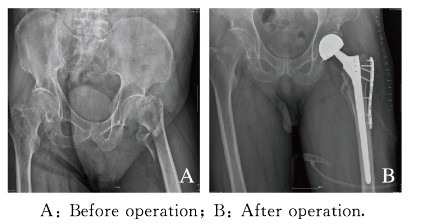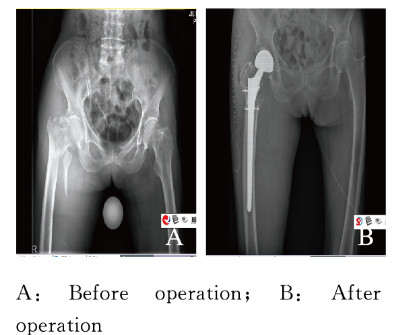扩展功能
文章信息
- 钟磊, 方红娟, 许猛, 侯婷婷, 侯越超, 王明礼
- ZHONG Lei, FANG Hongjuan, XU Meng, HOU Tingting, HOU Yuechao, WANG Mingli
- 胸骨钢丝捆绑与钢板固定大转子方式在不稳定股骨转子间骨折患者人工股骨头置换术中的应用及疗效比较
- Comparison of application and curative effects between sternal wire binding and plate fixation of greater trochanter in artificial femoral head replacement of patients with unstable intertrochanteric fracture
- 吉林大学学报(医学版), 2019, 45(03): 678-682
- Journal of Jilin University (Medicine Edition), 2019, 45(03): 678-682
- 10.13481/j.1671-587x.20190335
-
文章历史
- 收稿日期: 2018-02-12
2. 吉林大学第四医院电诊科, 吉林 长春 130000
2. Department of Electric Diagnosis, Fourth Hospital, Jilin University, Changchun 130000, China
股骨转子间骨折又名股骨粗隆间骨折,在日常生活中以老年人多见,其发病率逐年升高[1],占全身骨折的3%~4%[2],是临床上导致老年患者晚期生活质量下降的主要原因之一。老年人因激素水平和活动量减少等多种因素导致其多伴有严重的骨质疏松[3],所以轻微的外力即可导致骨折的发生,且骨折的类型多为不稳定型骨折[4]。对于该类患者的治疗,国内外已有大量文献[1-4]报道,主要采用的方法为人工股骨头置换和闭合复位髓内固定方式。因股骨转子间骨折为不稳定性骨折,累及粗隆部或粗隆下,选择股骨头置换术时普通假体已不适合,只能选择远端固定加长的骨水泥柄,但骨水泥亦有术中毒性,因此本文作者选择生物型假体进行置换术。
大转子是臀部主要肌肉的附着点,大转子重建可以恢复髋关节周围的力学平衡,这将有利于髋关节的稳定性[5]。大转子是术后测量下肢长度的重要解剖学标志,术中可以使人工股骨头中心与大转子顶点处于同一水平线上来推测肢体的长度,从而避免术后脱位乃至双下肢不等长等情况的发生,合理固定大转子还可以维持有效的外展肌张力。以往研究[6]着眼于骨水泥型假体的相关疗效,鲜有生物型假体疗效的相关报道,同时关于结合大转子不同功能重建方式对转子间不稳定骨折治疗效果影响尚未见相关报道。本文作者通过总结近一年对于该类患者的临床治疗和体会,创新性地提出了在术中应尽可能地保留大转子并重建其功能,将更有利于术后功能的恢复,效果明显[7]。目前,对大转子的复位重建主要有2种方法,其一是通过胸骨钢丝捆绑来固定,其二是采取钢板来固定。本文作者对比2种重建方式的效果,进而筛选出一种更加理想的大转子复位固定方式。
1 资料与方法 1.1 一般资料收集2015年5月—2016年5月吉林大学第二医院骨科医学中心关节外科收治的高龄转子间骨折患者的临床资料。纳入标准:年龄>70周岁,Evans-Jensen分型为Ⅱ、Ⅲ型,自愿接受手术治疗并签署手术知情同意书,无手术禁忌证,无活动性感染。排除标准:患者体质较差,内科疾病较多,不能承受手术的打击,术前存在髋部或者身体任意部位感染或术前患肢因原有疾病不能正常活动。骨折采用Evans-Jensen分型:Ⅰ型,2部分骨折,骨折无移位;Ⅱ型,2部分骨折,骨折有移位;Ⅲ型,3部分骨折,由于大转子骨折块移位而缺乏后外侧支持;Ⅳ型,3部分骨折,由于小转子骨折缺乏内侧支持;Ⅴ型,4部分骨折,缺乏内侧和外侧的支持, 为Ⅲ型和Ⅳ型骨折的结合。本研究主要纳入的是Ⅱ和Ⅲ型骨折患者。
共纳入52例患者,参考影像学结果,根据转子间粉碎程度将患者分为2组,均采用Wagner假体行人工股骨头置换治疗,粉碎程度轻者采用胸骨钢丝捆绑固定撕脱的大转子作为胸骨钢丝捆绑组,共28例,平均年龄为78.2(70~95)岁,其中男性9例,女性19例;粉碎程度严重者采用植入钢板固定撕脱的大转子作为钢板固定组,共24例,平均年龄为77.3(70~96)岁,其中男性8例,女性16例,2组患者一般资料比较差异无统计学意义(P>0.05)。
1.2 手术方法2组患者均采用腰硬联合麻醉方式,麻醉起效后取健侧卧位,髋关节后外侧入路,依次切开皮肤、皮下和筋膜,沿臀大肌纤维走行方向钝性分离臀大肌,保留臀中肌在股骨大转子处的附着点,切断短外旋肌群,“T”形切开关节囊,截断股骨颈,取出股骨头并测量直径以选择合适的人工骨股头。髓腔锉逐号增加处理股骨髓腔,根据术前设计及术中情况选择合适大小和偏距的假体柄,以15°前倾角植入Wagner假体。选择合适的股骨头颈,试行复位满意后安装假体,闭合关节囊。尽量保留大、小转子处有肌肉附着的较大及完整的骨折块,术中尽可能恢复大、小转子的解剖位置,2组患者分别采用胸骨钢丝和钢板固定大转子的骨块,采用大量生理盐水冲洗,置负压引流管1枚,逐层关闭切口。
1.3 围手术期处理开皮前0.5~2.0 h常规应用抗生素,术后24 h内追加1次抗生素,负压引流装置留置24~48 h,引流量少于30 mL时拔除引流管;术后12 h开始口服利伐沙班或皮下注射低分子肝素,预防下肢深静脉血栓。术后患者患肢肌力达到3级以上。
1.4 数据收集记录患者全程手术时间,失血量,输血量,术后引流量,患者初次下地时间,术后并发症发生率,出院时和术后1、3、6和12个月时髋关节X线片表现(影像学评估主要观察是否存在假体周围骨质的溶解和吸收,是否存在透亮线,以此判断是否存在假体松动)及髋关节功能Harris评分(90~100分为优,80~89分为良,70~79分为中,70分以下为差)。
1.5 随访随访时间为12~24个月,平均随访时间为17个月,失访5例,均因不同原因死亡。随访方式为门诊随访和电话随访,随访内容为术后髋关节功能评分(Harris评分)及是否发生假体松动。
1.6 统计学分析采用SPSS 15.0统计软件进行统计学分析。2组患者手术时间、失血量和术后引流量以x±s表示,组间比较采用t检验,2组患者术后并发症发生率,出院时和术后1、3、6和12个月时髋关节功能的Harris评分比较采用t检验。以P < 0.05为差异有统计学意义。
2 结果 2.1 2组患者手术时间、出血量和术后引流量2组患者均接受Wagner生物型假体行股骨头置换术,根据大粗隆粉碎程度不同采用胸骨钢丝捆绑固定或钢板固定大粗隆,见图 1和2(插页一)。2组患者手术时间和出血量比较差异有统计学意义(P < 0.05),2组患者术后引流量比较差异无统计学意义(P>0.05)。见表 1。

|
| 图 1 不稳定股骨转子间骨折患者行人工股骨头置换结合钢板固定大转子手术前后X线图像 Fig. 1 X-ray images of patients with unstable intertrochanteric fracture before and after femoral head replacement combined with plate fixation of great trochanter |
|
|

|
| 图 2 不稳定股骨转子间骨折患者行人工股骨头置换结合胸骨钢丝捆绑固定大转子手术前后X线图像 Fig. 2 X-ray images of patients with unstable intertrochanteric fracture before and after femoral head replacement combined with sternal wire binding of great trochanter |
|
|
| Group | n | Operation time (t/min) | Blood loss (V/mL) | Drainage volume after operation(V/mL) |
| Sternal wire binding | 28 | 50.40±7.60 | 250.00±10.00 | 115.00±35.00 |
| Plate fixation | 24 | 66.50±10.10 | 273.00±10.00 | 124.00±45.00 |
| P | < 0.05 | < 0.05 | >0.05 |
2组患者术后初次下地时间和术后早期并发症发生率比较差异无统计学意义(P>0.05),2组患者均无明显的术后不良反应。见表 2。
| (x±s) | |||
| Group | n | Time of getting off bed first (t/d) | Incidence of early complication(η/%) |
| Sternal wire binding | 28 | 3.00±2.00 | 10.70±0.00 |
| Plate fixation | 24 | 3.00±2.00 | 8.33±0.00 |
| P | >0.05 | >0.05 | |
2组患者术后髋关节功能Harris评分比较差异无统计学意义(P>0.05),见表 3。术后1年随访期间,52例患者随访X线均显示假体位置良好,无假体内外翻、下沉及松动迹象出现。2组患者假体周围透亮线发生情况无明显差异。
| (x±s) | |||||
| Group | n | Harris score | |||
| 12 d | 3 months | 6 months | 12 months | ||
| Sternal wire binding | 28 | 59.10±5.00 | 65.20±5.30 | 77.90±4.10 | 87.80±3.50 |
| Plate fixation | 24 | 59.00±5.10 | 61.10±5.50 | 73.40±3.60 | 83.60±3.40 |
| P | >0.05 | >0.05 | >0.05 | >0.05 | |
对于不稳定股骨转子间骨折的老年患者,治疗方式多倾向于手术治疗[8-14],以人工股骨头置换术最常见[15]。股骨大、小转子是判断前倾角和假体长度的重要生理解剖学标志,生理状态下股骨头中心应与股骨大转子顶点处于同一水平线上[16]:如果假体高度过低,患肢短缩将使外展肌无力从而导致术后髋关节容易发生脱位;相反如果假体高度过高,则使患肢延长而造成术中复位困难,进而术后患髋易疼痛并造成髋臼磨损和较差的关节活动度。外展肌无力是造成术后髋关节脱位的主要原因之一[17],因此术中股骨转子骨折的解剖复位及有效固定对手术治疗至关重要[18]。
本研究中人工股骨头置换术采用的是远端稳定的生物型股骨柄假体(Wagner假体),术者在手术中复位大转子骨折块后,分别常规采用胸骨钢丝于臀中肌深层绕经大转子处八字捆绑固定于假体上或通过钢板固定粉碎的大转子骨折块以恢复外展装置的完整性,进而臀中小肌、大转子及股外侧肌便可作为外侧稳定袖套结构的一个完整体,其连续性对于术后功能恢复及髋关节稳定性起至关重要的作用[18]。本研究结果显示:与钢板固定大转子骨折块比较,胸骨钢丝捆绑大转子骨折块具有手术时间短和出血量少的优点;2组患者术后初次下地时间和术后早期并发症发生率与钢板固定组并无明显差异,且2组患者在术后随访期间内均未发现假体移位和松动,髋关节Harris评分提示功能恢复良好,故所有患者于术后日常生活中能够自理,并无严重疼痛、功能障碍等并发症的发生,全部患者对手术疗效均非常满意。胸骨钢丝捆绑相较于钢板固定具有手术操作简便和损伤刺激小的优势,而2种固定方式均可以起到复位大转子从而重建大转子功能的作用,故2组患者术后初次下地时间、术后早期并发症发生率、术后随访期间内并发症的发生和髋关节Harris评分均未见明显差异。本研究中术后随访时间仅为1年,时间相对较短,因此对于2种术式远期疗效有待进一步探索。有文献[19-20]报道生物型假体治疗老年转子间骨折患者近期治疗效果比较满意,但未见有关大转子的复位重建在治疗中应用及疗效分析的报道,故这是本研究的创新点。从经济角度而言,胸骨钢丝的耗材费用明显低于钢板的耗材费用,可降低患者的手术费用,易被患者接受。
综上所述,在行人工股骨头置换治疗伴骨质疏松的不稳定大转子粉碎的股骨转子间骨折的老年患者术中,采用胸骨钢丝捆绑固定大转子的术式能够有效缩短手术时间、降低术中出血量,减小手术创伤,减少手术费用,同时术后骨折部位固定坚固牢靠,是一种理想的术中操作方式。
| [1] | POLAT M, ARSLAN A, UTKAN A. External fixation versus hemiartroplasty in unstable intertrochanteric hip fractures of the elderly[J]. Acta Orthopaed Belg, 2017, 88(3): 351–359. DOI:10.1080/17453674.2016.1277412 |
| [2] | HEINI P F. Femoroplasty-augmentation of mechanical properties in the osteoporotic proximal femur:a biomechanical investigation of PMMA reinforcement in cadaver bones[J]. Clin Biomech (Bristol, Avon), 2004, 19(5): 506–512. DOI:10.1016/j.clinbiomech.2004.01.014 |
| [3] | KANG S Y, LEE E W, KANG K S, et al. Mode of fixation failures of dynamic hip screw with TSP in the treatment of unstable proximal femur fracture:biomechanical analysis and a report of 3 cases[J]. J Korean Orthop Assoc, 2006, 41(1): 176–180. DOI:10.4055/jkoa.2006.41.1.176 |
| [4] | 张志山, 周方, 田耘, 等. 反向微创内固定系统治疗特殊类型股骨近端骨折[J]. 中华创伤杂志, 2009, 25(1): 48–52. DOI:10.3760/cma.j.issn.1001-8050.2009.01.16 |
| [5] | KEE H. Is rigid fixation of the greater trochanter necessary for arthroplasty of intertrochanteric fractures?[J]. Orthopaed Traumatol Surg Res, 2018, 26(2): 48–54. |
| [6] | CUI Q. Cemented hip hemiarthroplasty clinical observations on unstable intertrochanteric fracture in elderlies[J]. Eur J Trauma Emerg Surg, 2016, 42(5): 651–656. DOI:10.1007/s00068-015-0566-0 |
| [7] | 孙维国, 李皓桓, 彭飞, 等. 采用Wagner假体行人工股骨头置换治疗高龄股骨粗隆间不稳定骨折的疗效观察[J]. 武汉大学学报:医学版, 2014, 35(4): 613–616. |
| [8] | 郭小微, 李开南. 股骨粗隆间骨折手术风险评分系统的研究[J]. 中国骨与关节损伤杂志, 2014, 29(8): 759–762. |
| [9] | HWANG D S, KWAK S K, WOO S M. Results of cementless hemiarthroplasty for elderly patients with unstable intertrochanteric fractures[J]. J Korean Hip Soc, 2004, 16(3): 386–391. |
| [10] | JAHNG J H, SOHN J M, HA N K, et al. Primary bipolar hemiarthroplasty for treatment of unstable intertrochanteric fracture of the femur in elderly patients[J]. J Korean Hip Soc, 2005, 17(2): 76–82. |
| [11] | STOFFELEN D, HAENTJENS P, REYNDERS P, et al. Hip arthroplasty for failed internal fixation of intertrochanteric and subtrochanteric fractures in the elderly patient[J]. Acta Orthop Belg, 1994, 60(Suppl 1): 135–139. |
| [12] | TABSH I, WADDELL JP, MORTON J, et al. Total hip arthroplasty for complications of proximal femoral fractures[J]. J Orthop Trauma, 1997, 11(3): 166–169. DOI:10.1097/00005131-199704000-00005 |
| [13] | CHAN K C, GILL G S. Cemented hemiarthroplasties for elderly patients with intertrochanteric fractures[J]. Clin Orthop Relat Res, 2000(371): 206–215. |
| [14] | SIDHU A S, SINGH A P. Total hip replacement as primary treatment of unstable intertrochanteric fractures in elderly patients[J]. Int Orth, 2010, 34(6): 789–792. DOI:10.1007/s00264-009-0826-x |
| [15] | 储小兵, 杨予, 郝改平, 等. 新研制的老年不稳定型股骨粗隆间骨折半髋假体有限元分析[J]. 中国生物医学工程学报, 2012, 31(5): 729–735. DOI:10.3969/j.issn.0258-8021.2012.05.012 |
| [16] | 张明辉, 武豪杰, 陈欣欣, 等. 人工股骨头置换术治疗高龄不稳定股骨粗隆间骨折术中大粗隆骨折不同固定方法的比较[J]. 中国骨与关节损伤杂志, 2015, 30(10): 1090–1092. DOI:10.7531/j.issn.1672-9935.2015.10.026 |
| [17] | YANG E. New concepts in pertrochanteric hip fracture treatment[J]. Orthopedics, 2006, 29(11): 981–983. |
| [18] | 谢庆云, 张波, 权毅, 等. 人工双极股骨头置换中大转子不同固定方法的比较[J]. 中国组织工程研究与临床康复, 2011, 15(26): 4781–4784. DOI:10.3969/j.issn.1673-8225.2011.26.008 |
| [19] | KIM Y, MOON J K, HWANG K T, et al. Cementless bipolar hemiarthroplasty for unstable intertrochanteric fractures in octogenarians[J]. Acta Orthop Traumatol Turc, 2014, 48(4): 424–430. DOI:10.3944/AOTT.2014.13.0119 |
| [20] | LEE Y K, HA Y C, CHANG B K, et al. Cementless bipolar hemiarthroplasty using a hydroxyapatite-coated long stem for osteoporotic unstable intertrochanteric fractures[J]. J Arthroplasty, 2011, 26(4): 626–632. DOI:10.1016/j.arth.2010.05.010 |
 2019, Vol. 45
2019, Vol. 45


